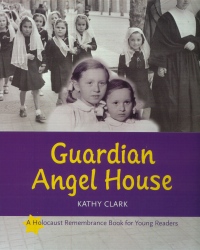| ________________
CM . . .
. Volume XV Number 22. . . .June 26, 2009 
 |
Guardian Angel House. (A Holocaust Remembrance Book for Young Readers).
Kathy Clark.
Toronto, ON: Second Story Press, 2009.
225 pp., pbk., $14.95.
ISBN 978-1-897187-58-6.
Subject Headings:
Holocaust, Jewish (1939-1945)-Hungary-Juvenile fiction.
Courage-Juvenile fiction.
Grades 3-6 / Ages 8-11.
Review by Harriet Zaidman.
*** /4
|
| |
|

excerpt:
"Don't worry, Mama, I will always take care of Vera." These were Susan's last words to her mother as they left. She repeated the words now, over and over in her mind, hoping to boost her courage.
On this early Sunday morning, three months after her father had been taken away, Susan clutched Aunt Isi's hand as if the pressure of her clasp could still the fluttering in the pit of her stomach. They were on their way to the convent on Gellert Mountain—two Jewish girls going to live with a group of nuns and already pretending they were part of the scattering of Catholics heading off to Sunday Mass.
Kathy Clark has recorded the story of how her mother, Vera, and Vera's older sister, Susan, were saved in World War II by guardian angels—good people who risked their own lives to defy the Nazi juggernaut.
These angels came in the form of their Aunt Isi, a non-Jew and their mother Rose's best friend, and nuns at the Sisters of Charity convent in Budapest, Hungary. Aunt Isi procured phony documents giving the children new Catholic identities, and the nuns pretended they were Catholic orphans to protect them from the Nazi round-ups. Susan and Vera joined over 120 other Jewish girls who were also being sheltered in the convent, sent by their parents who hoped that their children might survive the war. Many of the parents did not.
Clark's story recalls the anguish that Susan and Vera's mother experienced when she gave her children up, reminding them to always remember their Jewish identity. Preadolescent Susan was the guardian not only of five-year-old Vera, but also of their heritage, and she struggled with the expectation that she adopt Catholic rituals and prayers. The kindness of the nuns soon overcame Susan's fears and loneliness. She became involved with the care of the other children, the work of the convent to feed the poor, and learned the stories of other Jewish children who were going through similar trauma. She realized that the church sanctuary and the Catholic rituals were not unlike Jewish synagogues and customs. Her friendship with one nun gave her hope for the future.
Susan and Vera were hidden by the nuns for over a year until the war finally ended. They were among the lucky ones to be reunited with their parents, but their baby brother had died. The difficult situation in post-war Hungary caused them to look for a new home, a decision made easier when they received a letter from Aunt Isi who had found her way to Toronto. She urged the family to join her. They learned Aunt Isi had given Rose's name to the Swedish diplomat, Raoul Wallenberg, which was why Rose had been plucked from a train bound for a concentration camp. Wallenberg was another guardian angel who selflessly saved tens of thousands of Hungarian Jews from the death camps.
Clark has written the story focussing on her Aunt Susan since little Vera was far more adaptable and less aware of the dangers they faced. Clark details aspects of their daily life so that children in the target age group will be able to identify with the difficulties and unhappiness the sisters experienced. Children will understand how people lived in Hungary, how they made it through day-to-day during the war, and learn about religious customs of both Jews and Catholics. They will appreciate how brave some people were despite the regime of terror the Nazis imposed, and the sacrifices these individuals made to do the right thing.
The recreated story includes several heart-stopping moments, such as the time the girls barely escaped detection after the Nazis burst into the convent and the day an unexploded bomb was discovered in the yard. Clark includes the story of an older girl, Julie, and that of a gypsy, Lena, but the large group of children who were being sheltered seems to be forgotten at times, reducing for the reader the impact of the enormity of the nuns' work and the dynamics of the group—parentless children in an unfamiliar place in a dangerous situation.
Nevertheless, Guardian Angel House will prove to be a popular book in school libraries and for personal purchases. It joins the other books in Second Story Press's "Holocaust Remembrance" series—Hana's Suitcase, The Underground Reporters, Hiding Edith and The Righteous Smuggler, in contributing to the important body of books that document the history of children during this dark time.
Recommended.
Harriet Zaidman is a teacher-librarian in Winnipeg, MB.

To comment
on this title or this review, send mail to cm@umanitoba.ca.
Copyright © the Manitoba Library Association. Reproduction for personal
use is permitted only if this copyright notice is maintained. Any
other reproduction is prohibited without permission.
NEXT REVIEW |
TABLE OF CONTENTS FOR THIS ISSUE
- June 26, 2009.
AUTHORS |
TITLES |
MEDIA REVIEWS |
PROFILES |
BACK ISSUES |
SEARCH |
CMARCHIVE |
HOME |
